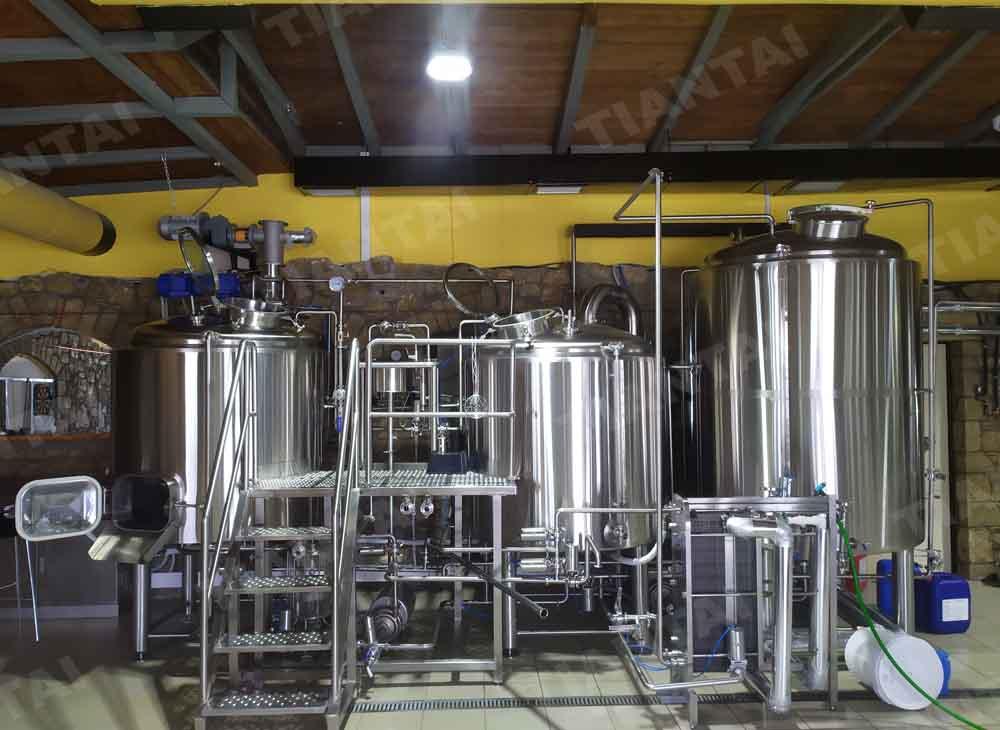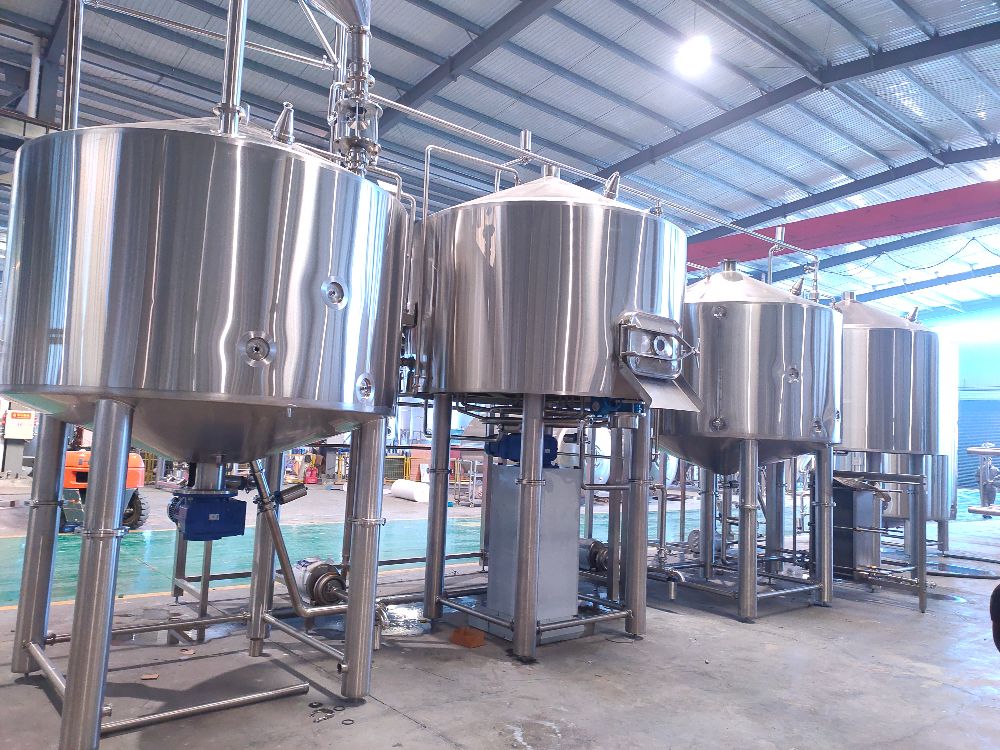The Difference Between Commercial Brewing Equipment and Microbrewery Equipment
- Jan 06, 2022
- 166
- tiantai
Brewing is the creation of lager by soaking a starch source (ordinarily oat grains, the most well known of which is grain) in water and aging the subsequent sweet fluid with yeast. It might be done in a bottling works by a business brewer, or by an assortment of conventional strategies, for example, collectively by the indigenous people groups in Brazil when making cauim. Brewing has occurred since around the sixth thousand years BC, and archaeologist proof proposes that developing human advancements including antiquated Egypt and Mesopotamia fermented lager. Since the nineteenth century, the brewing business has been a piece of most western economies.
Ventures in the preparing procedure incorporate malting, processing, crushing, lautering, bubbling, maturing, molding, sifting, and bundling. There are three primary aging strategies, warm, cool, and unconstrained. Maturation may happen in an open or shut aging vessel. Auxiliary aging may likewise happen in the barrel or jug. There are a few extra blending strategies, for example, barrel maturing, twofold dropping, and Yorkshire Square. For starters who wanted to build up a commercial brewing business, it’s going to be a big ride on the big ones. Starting on machines, commercial brewing is a large brewing company that uses massive apparatus to create loads of barrels of beers a day that can be exported in different places at a time, most likely to be found at the market.
On the other hand, Microbrewery or mini brewery is normally connected to distilleries that are a lot littler than substantial scale corporate bottling works and are claimed autonomously. There are predominant accentuation portrayed when it comes to flavor and preparing a strategy on the bottling works. We offer a Microbrewery (smaller than usual bottling works) with the profitability of 1000L (10 hl) to 12000L (50hl) per mix. The administration incorporates: total arrangement of microbrewery hardware, establishment turnkey, formulas and innovation of marked brews, staff preparing and the sky is the limit from there. Microbrewery comes with a total “turnkey”. The execution of your Microbrewery (Bottling works and scaled down distillery) if fundamental, can be expanded later on.
Down below are some key instances of strategies, and the things business brewers must be aware of when blending on bigger frameworks over the smaller ones.

Synthetic substances: This one is night and day. Business brewers, for the most part, utilize a lot more grounded synthetic compounds when cleaning and purifying than a microbrewery, who generally don’t generally approach a similar level of items, and all things considered. Purifying and cleaning is an essential and tedious part of business preparing. Business brewers use a CIP (clean set up) framework for a large portion of their vessel cleaning. A CIP framework, as a rule, comes as a shower ball inside the vessel, close to the roof that enables synthetics to course down the dividers of the tank peeling off a wide range of grime all the while. Synthetics, for example, burning soft drink, phosphoric and nitric corrosive do some incredible things and require higher temperatures in the 150-160 Fahrenheit range for full viability. For sterilization, we use per-acetic corrosive, which is deplorable to be around at any volume when it’s not weakened. For micro-brewers, they may experience the same unwanted synthetic substances that may come in the operation of processing brewed beers who for the most uses only small scale machinery.
Consistency: Crafting incredible lager is a balance of craftsmanship and science; However in an industry where consistency is above all else, we need to leave our experimentation to our very own home-brew framework. One of my most loved pieces of home blending is part of a group of something into two distinct tanks and doing uncontrollably extraordinary things with them regarding yeast, dry-jump, or different added substances. Lamentably, when you’re a mixed place of our size, that kind of experimentation is generally held for firkin and barrel-maturing, which considers a great deal of opportunity, yet not as much as you have before aging even starts. Micro-brewers will dependably be on small outputs of the product that can always create a thicker texture on the first product to the second one. It can likewise bargain the brew to include certain fixings at specific stages all the while, which can essentially diminish a lager’s time-frame of realistic usability if the arrangement is to place it in a plane or a six-pack.
Efficiencies: Larger frameworks in business preparing are progressively productive with regards to separating what you look for from a fixing. For instance, you’ll get more IBU’s/sugars/and so on from bigger frameworks, which spares you cash as a brewer. Microbreweries would need to utilize more grain and longer squash times to reproduce the business make efficiencies for it can only hold up a small amount of product, smaller equipment that tends to be more time consuming than using a commercial brewery machine wherein the storage is quite larger.
Temperatures: each vessel is set up to get either steam or glycol. Consider glycol a sort of ‘liquid catalyst.’ It’s utilized on the “cool side” of the bottling works to direct the temperature of our fermenters, monitoring the warmth created by maturation. Microbreweries can also keep pace with the same outcome of the equipment’s performance because microbrewery machines also use an apparatus to release the exact amount of heat needed for the brewed beers to be able to get the wanted result for the beers.
As a result, commercial brewery equipment are more profitable than the microbrewery equipment for it has a larger storage that can hold up to 500 gallons a day, they have more complex attributes than the microbrewery equipment and more developed properties resulting to a more profitable way and a faster way to make beer. Both are a good way to earn in a business. But for a starting firm, they are more likely be able to use a microbrewery type of craft brewery for the needed equipment are less like smaller than the commercial brewery equipment, meaning it will have a lesser price than the price of the commercial brewery equipment, depending on the capital of the entrepreneur may hold.
Derrick
Sales Manager
[email protected]
Tiantai Beer Equipment
Ventures in the preparing procedure incorporate malting, processing, crushing, lautering, bubbling, maturing, molding, sifting, and bundling. There are three primary aging strategies, warm, cool, and unconstrained. Maturation may happen in an open or shut aging vessel. Auxiliary aging may likewise happen in the barrel or jug. There are a few extra blending strategies, for example, barrel maturing, twofold dropping, and Yorkshire Square. For starters who wanted to build up a commercial brewing business, it’s going to be a big ride on the big ones. Starting on machines, commercial brewing is a large brewing company that uses massive apparatus to create loads of barrels of beers a day that can be exported in different places at a time, most likely to be found at the market.
On the other hand, Microbrewery or mini brewery is normally connected to distilleries that are a lot littler than substantial scale corporate bottling works and are claimed autonomously. There are predominant accentuation portrayed when it comes to flavor and preparing a strategy on the bottling works. We offer a Microbrewery (smaller than usual bottling works) with the profitability of 1000L (10 hl) to 12000L (50hl) per mix. The administration incorporates: total arrangement of microbrewery hardware, establishment turnkey, formulas and innovation of marked brews, staff preparing and the sky is the limit from there. Microbrewery comes with a total “turnkey”. The execution of your Microbrewery (Bottling works and scaled down distillery) if fundamental, can be expanded later on.
Down below are some key instances of strategies, and the things business brewers must be aware of when blending on bigger frameworks over the smaller ones.

Synthetic substances: This one is night and day. Business brewers, for the most part, utilize a lot more grounded synthetic compounds when cleaning and purifying than a microbrewery, who generally don’t generally approach a similar level of items, and all things considered. Purifying and cleaning is an essential and tedious part of business preparing. Business brewers use a CIP (clean set up) framework for a large portion of their vessel cleaning. A CIP framework, as a rule, comes as a shower ball inside the vessel, close to the roof that enables synthetics to course down the dividers of the tank peeling off a wide range of grime all the while. Synthetics, for example, burning soft drink, phosphoric and nitric corrosive do some incredible things and require higher temperatures in the 150-160 Fahrenheit range for full viability. For sterilization, we use per-acetic corrosive, which is deplorable to be around at any volume when it’s not weakened. For micro-brewers, they may experience the same unwanted synthetic substances that may come in the operation of processing brewed beers who for the most uses only small scale machinery.
Consistency: Crafting incredible lager is a balance of craftsmanship and science; However in an industry where consistency is above all else, we need to leave our experimentation to our very own home-brew framework. One of my most loved pieces of home blending is part of a group of something into two distinct tanks and doing uncontrollably extraordinary things with them regarding yeast, dry-jump, or different added substances. Lamentably, when you’re a mixed place of our size, that kind of experimentation is generally held for firkin and barrel-maturing, which considers a great deal of opportunity, yet not as much as you have before aging even starts. Micro-brewers will dependably be on small outputs of the product that can always create a thicker texture on the first product to the second one. It can likewise bargain the brew to include certain fixings at specific stages all the while, which can essentially diminish a lager’s time-frame of realistic usability if the arrangement is to place it in a plane or a six-pack.
Efficiencies: Larger frameworks in business preparing are progressively productive with regards to separating what you look for from a fixing. For instance, you’ll get more IBU’s/sugars/and so on from bigger frameworks, which spares you cash as a brewer. Microbreweries would need to utilize more grain and longer squash times to reproduce the business make efficiencies for it can only hold up a small amount of product, smaller equipment that tends to be more time consuming than using a commercial brewery machine wherein the storage is quite larger.
Temperatures: each vessel is set up to get either steam or glycol. Consider glycol a sort of ‘liquid catalyst.’ It’s utilized on the “cool side” of the bottling works to direct the temperature of our fermenters, monitoring the warmth created by maturation. Microbreweries can also keep pace with the same outcome of the equipment’s performance because microbrewery machines also use an apparatus to release the exact amount of heat needed for the brewed beers to be able to get the wanted result for the beers.
As a result, commercial brewery equipment are more profitable than the microbrewery equipment for it has a larger storage that can hold up to 500 gallons a day, they have more complex attributes than the microbrewery equipment and more developed properties resulting to a more profitable way and a faster way to make beer. Both are a good way to earn in a business. But for a starting firm, they are more likely be able to use a microbrewery type of craft brewery for the needed equipment are less like smaller than the commercial brewery equipment, meaning it will have a lesser price than the price of the commercial brewery equipment, depending on the capital of the entrepreneur may hold.
Derrick
Sales Manager
[email protected]
Tiantai Beer Equipment



.jpg)
